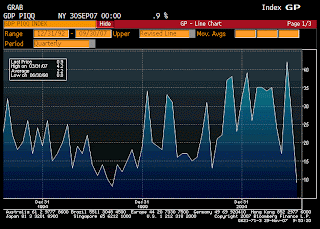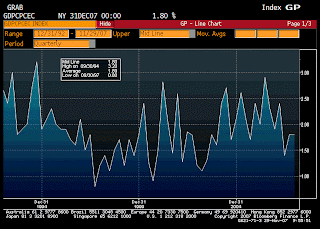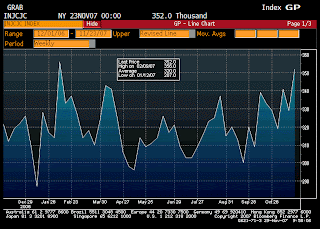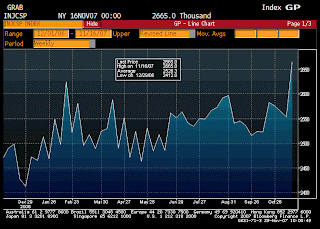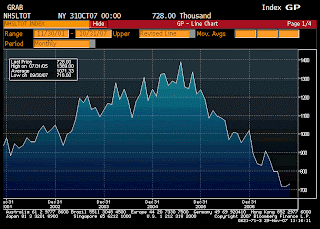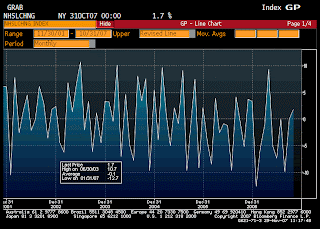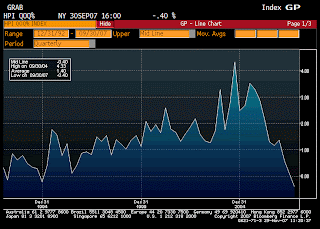A very British bubble for Mr Brown
Leader
Sunday December 16 2007
The ObserverThe buzz words in the world of finance these days are ‘moral hazard’. That is economist-speak for what happens when people who have engaged in risky business and fallen foul of market forces are let off the hook. It is the recognition that when you give dodgy lenders and borrowers an inch, they recklessly gamble for another mile.
When the City started to feel the ‘credit crunch’ over the summer, the Bank of England at first took a tough line on moral hazard. But it subsequently changed its mind. It rescued Northern Rock.
It rescued the depositors. Hardly a moral hazard issue. The shareholders still stand to lose if the assets don’t have the hoped for cash flows over time.
Last week it joined a coordinated action with US, Canadian and European central banks to provide easy credit to any institution that can’t borrow elsewhere.
Sort of, the CB’s job is to administer policy interest rates. And, again, there is nothing yet to indicate shareholders are getting baled out.
That was the right course of action. The banking sector may be in a mess of its own making – it over-exposed itself to US sub-prime mortgages – but the danger to the wider economy of a prolonged cash drought is too big to ignore.
What is a ‘cash drought’???
But even if last week’s intervention gets the wheels of global finance moving again,
Whatever that means. GDP seems to be muddling through as before.
the danger will not have receded. That is because high street lenders have no reason to pass central bank largesse onto their customers. Ordinary people will still find it hard to borrow and will still pay more than before to service their debts.
Haven’t seen any evidence of that, apart from would be subprime borrowers who perhaps never should have had access to funds anyway.
Since Britons are some of the most indebted people in the world, that puts us in a particularly vulnerable position. Per capita, Britons borrow more than twice as much as other Europeans. The average family pays 18 per cent of disposable income servicing debt. If the world economy slumps, the bailiffs will knock at British doors first.
More confused rhetoric. Aggregate demand is about spending. The risk to output and employment remains a slump in spending.
It might not come to that. The best case scenario envisages a mild downturn, consumers turning more prudent, demand dipping and inflation falling, which would free the Bank of England to cut interest rates and re-energise the economy for a prompt comeback.
No evidence cutting rates adds to demand in a meaningful way. It takes a strong dose of fiscal for that or for the non resident sector to start spending its hoard of pounds in the UK.
But in the worst case scenario, the credit crunch turns into a consumer recession.
If it results in a cut in aggregate demand, which it might, but somehow this discussion does not get into that connection.
House prices fall dramatically. People feel much poorer and stop spending.
OK, there is a possible channel, but it is a weak argument. Seems to take a cut in income for spending to fall.
Small businesses can’t get credit and fold.
Could happen, but if consumers spend at the remaining businesses that do not fold and employment and income stays constant, GDP stays pretty much the same.
But high fuel and commodity prices keep inflation high. Unemployment rises
When that happens, it is trouble for GDP, but he skirts around the channels that might lead to a loss of income, spending, and employment.
and millions of people default on their debts. Boom turns to bust.
Right, and the policy response can be an immediate fiscal measure that sustains demand and prevents that from happening.
The problem is with ‘high inflation’ and an inherent fear of government deficits; policy makers may not want to go that route.
The government can hope for the best, but it must prepare for the worst.
Fallout shelters?
That means talking to banks, regulators and debt relief charities to work out ways to help people at risk of insolvency.
Actually, bankruptcy is a means of sustaining demand. Past debts are gone and earned income goes toward spending and often spending beyond current income via new debt.
They must look first at reform of Individual Voluntary Arrangements. These are debt restructuring packages that fall short of personal bankruptcy declarations. In theory, they allow people to consolidate and write off some of their debt, paying the rest in installments.
This could hurt demand unless the installment payments get spend by the recipients.
There is no debtors prison over there anymore, last I heard?
But in practice they are sometimes scarcely more generous than credit card balance transfer deals, with large arrangement fees and tricky small print. There is emerging evidence they have been mis-sold to desperate debtors.
In theory, individuals can also negotiate debt relief directly with banks. But that requires the pairing of a financially literate, assertive consumer with a generous-hearted lender – not the most common combination. The government and banks should already be planning their strategy to make impartial brokering of such deals easier.
But the first hurdle on the way to easing a private debt crisis is political. Gordon Brown has constructed a mythology of himself as the alchemist Chancellor who eliminated the cycle of boom-and-bust from Britain’s economy. To stay consistent with that line, he has to pretend that Britain is well insulated from financial turbulence originating in the US.
Banning CNBC would help out a lot!
That simply isn’t true. The excessive level of consumer borrowing in recent years is a very British bubble and the government can deny it no longer. If the bubble bursts, we will face a kind of moral hazard very different from the one calculated by central banks when bailing out the City. It is the hazard of millions of people falling into penury.
Rising incomes can sustain rising debt indefinitely. It is up to the banks to make loans to people who can service them; otherwise, their shareholders lose. That is the market discipline, not short term bank funding issues.
♥



